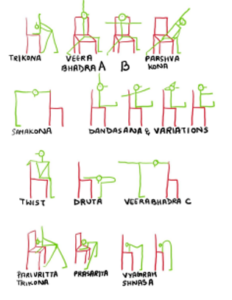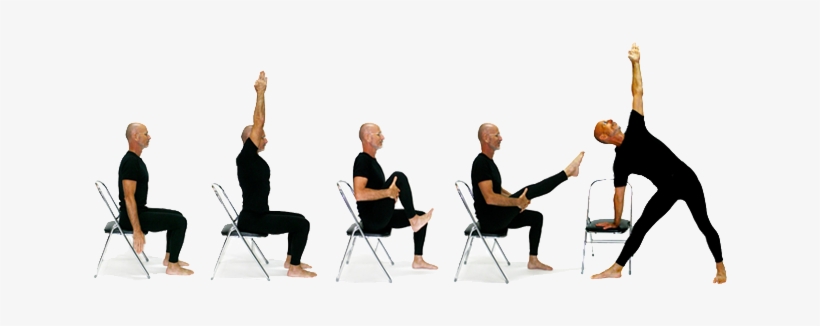Yoga from Chair to Mat
Why Chair Yoga?
One of the several reasons for people to not practice yoga is the difficulty to sit on the floor, due to knee related issues. Knee issues may either be due to an injury or chronic pain developed over the years. Practicing yoga in a regular group class may be a challenge and personal yoga sessions may be unaffordable.
Leading to not practicing yoga and reaping it’s benefits. Knee pain tends to become chronic in nature and seems to be irreversible.
Some of the reasons for Knee issues include-
- After the age of 55, the calcium levels in the body reduce, hence the bone related issues begin. This generally leads to pains in knee joints and ultimately difficulty sitting on the floor. So a regular group yoga class may not be ideal for them.
- Due to incorrect postures, after prolonged pain in knees. There are other posture related issues arising like pain in lower back, stiffness in neck and shoulders, difficulty in walking etc. Eventually reducing physical activity during the day and leading to further health problems.
- Due to lifestyle habits and incorrect eating, digestive system and respiratory system related issues begin to arise as well. This leads to breathing difficulties, so an intense yoga practice in a group may not be ideal.
- Due to hormonal changes, overall mental and physical health takes a toll and without yoga practice, all of the above issues become a challenge to manage and become chronic in nature.
Therefore, generally when a person comes with a difficulty in knee joint, usually there involves many other things that need to be taken care of and not just the knees. For instance, along with the knee joint pain there may be regular migraine issues, diabetes, high blood pressure, obesity, shoulder issues, acidity etc. all in one person.
So instead of treating just the knees, we need to take a more holistic approach.
How do we go about this?
Comfort
During practice we must ensure that students don’t have any pain. Any positions which give them pain should not be done. Most issues have been chronic and developed over the years, thus we need to take it very slow with practice and incorporate yoga into their life.
Correction of yoga posture
This is going to be the key. It is important not only to correct the standing yoga asanas but also the sitting postures. As most of the time is spent sitting on the chair. Teaching the importance of sitting correctly on the chair is going to be extremely valuable. This includes knee ankle alignment and spine lift.
Dietary guidance
Apart from yoga, its important to provide guidance about the small changes they can make in their diet. Remember drastic changes may not be sustainable. Giving smaller and simpler changes in diet can make a big difference. For example, eating seasonal fruits, not eating refined sugar products, not eating non vegetarian at night, avoiding packaged food like ketchup, jams, things containing preservatives etc. As they move further along in practice, mindfulness increases and gradually they can be more mindful towards what goes in the mouth.
Always remember, the body is not a garbage disposal. Be mindful of what you feed the body as taste stays only 30 secs, toxins stay longer. Prioritize nutrition over instant gratification.
Counselling and awareness
Regular counselling and awareness regarding the importance of good physical and mental health. How important “me” time is. It is our duty to take care of our most prized possession.
Practices that shall help in overall health improvement
While planning a class, always remember to include movements in all directions: forward bend, backward bend, lateral bend, twisting and mild inversions.
Sukshma vyayama
It should be done almost every day to improve mobility of the joints.
Breathing techniques
This also has to be done every day as breathing correctly is going to have a deep impact on all the other practices.
- Hands in and out breathing
- Hands stretch breathing (depending on the mobility of the shoulder) 3. Ankle stretch breathing (modified in cases of obesity)
- Lateral bending
- Twisting
Keep in mind what may seem easy to us may be a challenge for them, being mindful of this is very important. Initially we start the practice by having them sit on the chair preferably without an armrest. Practice may be done in a combination of standing position and sitting position. So that they don’t feel tired and exhausted during practice. Ensure the chair is sturdy and doesn’t slip during practice.
Asanas
Asana yoga practice can be started with support of the chair and gradually as stamina builds chair usage can be minimized.

How to stand and sit
This is essential in order to lift the weight of the knees and to avoid more wear and tear. Gradually, teach them the correct method of movement from standing to sitting and sitting to standing. Pushing the hip back, engaging core, using thigh muscles and knee-ankle in one line. Using this technique makes it easier to stand and sit. Work on strengthening the calves, hamstrings and quadriceps everyday.
Floor practice
Gradually, once a week add floor practice. In the floor practice do not force to sit in sukhasana as it may be a challenge. Sitting with feet stretched out. On the day of floor practice don’t make them stand, as standing and sitting often shall be a challenge for them. Here, dandasana, padangustha dandasana, baddhakonasana, janushirshasana, upavisthakonasana, gatyatmak meru vakrasana, chakki chalanasana, vyaghra swasa, bhujangasana breathing, shalabhasana breathing, urdhva prasarita padasana, pada chakrasana, pada sanchalana, setu bandhasana breathing, pawan mukhtasana, jataraparivarthanasana. These can be done being on the bed as well.

Malasana
Working on malasana to achieve the goal of sitting on the floor. Janu Naman, janu chakra, ardha titli asana, shroni chakrasana are knee and hip joint specific movements. As the mobility in the knees improves, gradually folding the leg to bring the heel closer to buttocks without pain should become easier.

Pranayama practice
Every day pranayama is vital for holistic health and recovery. Pranayama works wonderfully in recovery, basic simple techniques can be taught to bring down anxiety and stress levels. As mental health gets better the desire and willingness to take care of physical health increases.
- Kapalbhati- mild version
- Abdominal breathing, thoracic breathing, clavicular breathing
- Surya anulom, Chandra anulom
- Chandra bhedana, Surya bhedana
- Nadi shodhana
- Ujjayi breathing
- Brahmari
Cleansing practice
like mukha dhauti, jala neti, and trataka along with eye exercises can be taught.
Conclusion
As Chair yoga practice continues consistently, many problems may disappear and movement from standing to sitting may become smoother and simpler. Thus, one shall be able to shift to a yoga mat and begin to practice modified versions of Suryanamaskara. Eventually build the stamina and agility to practice in a regular group yoga class.
The major root causes of most problems in people today are stress and incorrect posture. Targeting on elimination of these solves many problems. If yoga practice is regular from an early age, it will eliminate many long term health problems.
Working on annamaya kosha, pranayama kosha and manomaya kosha shall bring about a great difference in the journey to recovery. Consistency is the key to achieve any results. Practice each day with mindfulness and alignment.
Yogic knowledge is a Powerful tool to bring a change in the overall health and wellness of a person. Therefore, our goal should be to educate and help. Educating people in making chair yoga a lifestyle habit is our goal as yoga teachers.
This blog was originally written by Fatema Abbas Hararwala, Level 2 Indea Yoga Teacher, and edited by Team Indea Yoga. This was a part of his dissertation work during her Level 2 Teacher Training Course.




